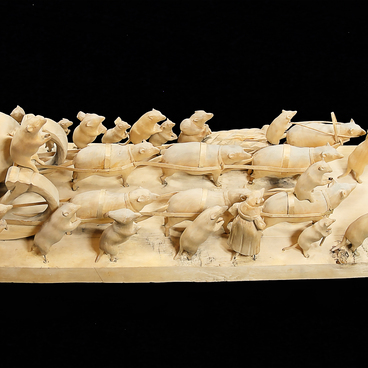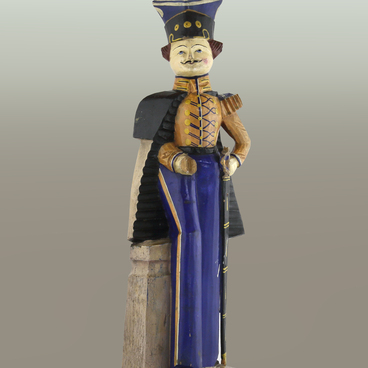The sculptural group “Meeting a Militiaman from the War of 1812” was made by the hereditary Bogorodsk carver Andrey Yakovlevich Chushkin (1882–1933). He created the composition in preparation for the anniversary exhibition, timed to coincide with the centenary of the Patriotic War of 1812. The exhibition was held at the Historical Museum in Moscow. This is a very free interpretation of the motifs of two popular paintings by Ivan Vasilyevich Luchaninov: “Blessing of a Militiaman of 1812” and “Return of the Warrior to His Family.” The painting “Blessing of the Militiaman” was also repeated in the form of an engraving by Andrey Grigoryevich Ukhtomsky.
The craftsman creatively interpreted the pictorial plot in accordance with the expressive possibilities of wooden carving. The three-figure composition is minimalistic, but its plot is expressive: we see the woman rushing to meet her husband returning from the war, the warrior stretching out his arms, and the happy child clinging to him. Andrey Chushkin emphasized that his character was a peasant. He is a militiaman — he has a saber and a uniform cap, but he wears striped peasant trousers.
Embodying memorable graphic scenes in sculpture required a craftsman, who had the skills of traditional carving, creative imagination and understanding of composition. The artisan had to create a new plot, uncharacteristic of the traditional Bogorodsk craft. Andrey Chushkin was such a master. He created a whole cycle of sculptural groups titled “1812” based on the cartoons of Ivan Terebenev, including “The Russian People Guard the Kremlin from Napoleon” and “Peasant Sweeps the French out of the Kremlin with a Broom”, in which a large image of a peasant confronts the small figures of enemies who are swept away from his native land.
In 1912, Andrey Chushkin participated in the exhibition “1812” and received a bronze medal on the Vladimir ribbon. The theme of meeting warriors returning from the war was associated with the end of the military upheavals of the new 20th century. The scene of meeting a returning soldier resonated in the hearts of the Russian people, and Chushkin repeated it many times until 1925. The exhibit entered the collection of the Russian Museum from the collection of the famous folklorist Natalya Pavlovna Kolpakova.
Andrey Yakovlevich Chushkin was one of the co-founders of the Bogorodsk Handicraft Toy-Carving Artel (1913), an instructor of toy workshops in Bogorodsk and Sergiev Posad, and after the revolution — in Moscow. The photo features the craftsman at work in the film “The Adventures of Bolvashka” (1927, “Mezhrabpom-Rus”, directed by Yuri Zhelyabuzhsky).
The craftsman creatively interpreted the pictorial plot in accordance with the expressive possibilities of wooden carving. The three-figure composition is minimalistic, but its plot is expressive: we see the woman rushing to meet her husband returning from the war, the warrior stretching out his arms, and the happy child clinging to him. Andrey Chushkin emphasized that his character was a peasant. He is a militiaman — he has a saber and a uniform cap, but he wears striped peasant trousers.
Embodying memorable graphic scenes in sculpture required a craftsman, who had the skills of traditional carving, creative imagination and understanding of composition. The artisan had to create a new plot, uncharacteristic of the traditional Bogorodsk craft. Andrey Chushkin was such a master. He created a whole cycle of sculptural groups titled “1812” based on the cartoons of Ivan Terebenev, including “The Russian People Guard the Kremlin from Napoleon” and “Peasant Sweeps the French out of the Kremlin with a Broom”, in which a large image of a peasant confronts the small figures of enemies who are swept away from his native land.
In 1912, Andrey Chushkin participated in the exhibition “1812” and received a bronze medal on the Vladimir ribbon. The theme of meeting warriors returning from the war was associated with the end of the military upheavals of the new 20th century. The scene of meeting a returning soldier resonated in the hearts of the Russian people, and Chushkin repeated it many times until 1925. The exhibit entered the collection of the Russian Museum from the collection of the famous folklorist Natalya Pavlovna Kolpakova.
Andrey Yakovlevich Chushkin was one of the co-founders of the Bogorodsk Handicraft Toy-Carving Artel (1913), an instructor of toy workshops in Bogorodsk and Sergiev Posad, and after the revolution — in Moscow. The photo features the craftsman at work in the film “The Adventures of Bolvashka” (1927, “Mezhrabpom-Rus”, directed by Yuri Zhelyabuzhsky).



